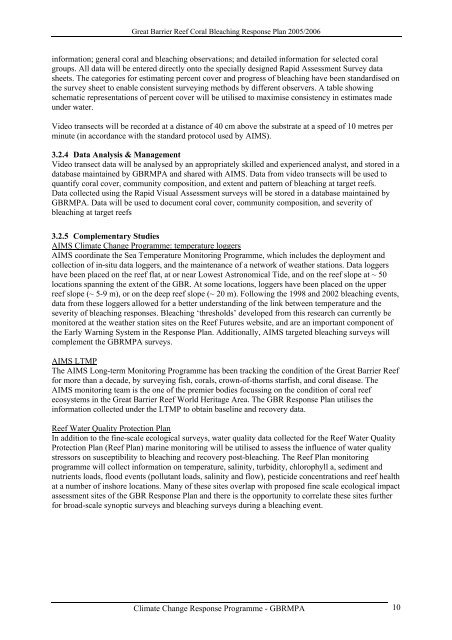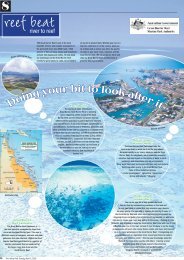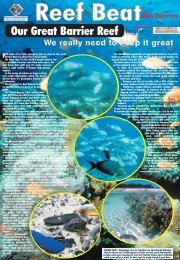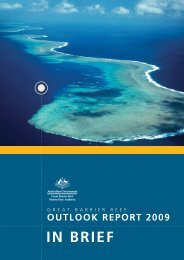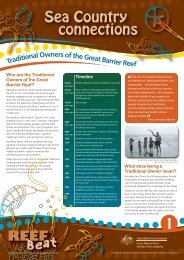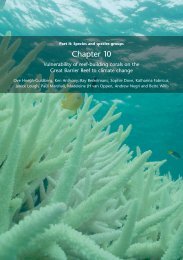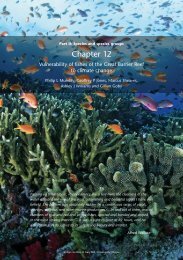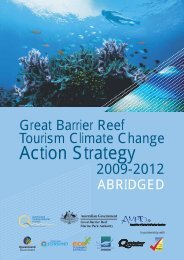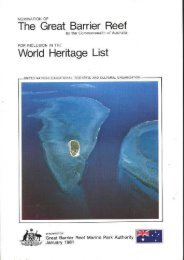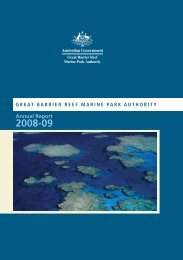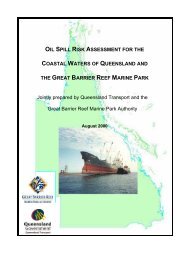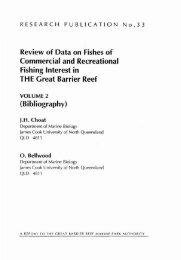Coral Bleaching Response Plan - Great Barrier Reef Marine Park ...
Coral Bleaching Response Plan - Great Barrier Reef Marine Park ...
Coral Bleaching Response Plan - Great Barrier Reef Marine Park ...
Create successful ePaper yourself
Turn your PDF publications into a flip-book with our unique Google optimized e-Paper software.
<strong>Great</strong> <strong>Barrier</strong> <strong>Reef</strong> <strong>Coral</strong> <strong>Bleaching</strong> <strong>Response</strong> <strong>Plan</strong> 2005/2006<br />
information; general coral and bleaching observations; and detailed information for selected coral<br />
groups. All data will be entered directly onto the specially designed Rapid Assessment Survey data<br />
sheets. The categories for estimating percent cover and progress of bleaching have been standardised on<br />
the survey sheet to enable consistent surveying methods by different observers. A table showing<br />
schematic representations of percent cover will be utilised to maximise consistency in estimates made<br />
under water.<br />
Video transects will be recorded at a distance of 40 cm above the substrate at a speed of 10 metres per<br />
minute (in accordance with the standard protocol used by AIMS).<br />
3.2.4 Data Analysis & Management<br />
Video transect data will be analysed by an appropriately skilled and experienced analyst, and stored in a<br />
database maintained by GBRMPA and shared with AIMS. Data from video transects will be used to<br />
quantify coral cover, community composition, and extent and pattern of bleaching at target reefs.<br />
Data collected using the Rapid Visual Assessment surveys will be stored in a database maintained by<br />
GBRMPA. Data will be used to document coral cover, community composition, and severity of<br />
bleaching at target reefs<br />
3.2.5 Complementary Studies<br />
AIMS Climate Change Programme: temperature loggers<br />
AIMS coordinate the Sea Temperature Monitoring Programme, which includes the deployment and<br />
collection of in-situ data loggers, and the maintenance of a network of weather stations. Data loggers<br />
have been placed on the reef flat, at or near Lowest Astronomical Tide, and on the reef slope at ~ 50<br />
locations spanning the extent of the GBR. At some locations, loggers have been placed on the upper<br />
reef slope (~ 5-9 m), or on the deep reef slope (~ 20 m). Following the 1998 and 2002 bleaching events,<br />
data from these loggers allowed for a better understanding of the link between temperature and the<br />
severity of bleaching responses. <strong>Bleaching</strong> ‘thresholds’ developed from this research can currently be<br />
monitored at the weather station sites on the <strong>Reef</strong> Futures website, and are an important component of<br />
the Early Warning System in the <strong>Response</strong> <strong>Plan</strong>. Additionally, AIMS targeted bleaching surveys will<br />
complement the GBRMPA surveys.<br />
AIMS LTMP<br />
The AIMS Long-term Monitoring Programme has been tracking the condition of the <strong>Great</strong> <strong>Barrier</strong> <strong>Reef</strong><br />
for more than a decade, by surveying fish, corals, crown-of-thorns starfish, and coral disease. The<br />
AIMS monitoring team is the one of the premier bodies focussing on the condition of coral reef<br />
ecosystems in the <strong>Great</strong> <strong>Barrier</strong> <strong>Reef</strong> World Heritage Area. The GBR <strong>Response</strong> <strong>Plan</strong> utilises the<br />
information collected under the LTMP to obtain baseline and recovery data.<br />
<strong>Reef</strong> Water Quality Protection <strong>Plan</strong><br />
In addition to the fine-scale ecological surveys, water quality data collected for the <strong>Reef</strong> Water Quality<br />
Protection <strong>Plan</strong> (<strong>Reef</strong> <strong>Plan</strong>) marine monitoring will be utilised to assess the influence of water quality<br />
stressors on susceptibility to bleaching and recovery post-bleaching. The <strong>Reef</strong> <strong>Plan</strong> monitoring<br />
programme will collect information on temperature, salinity, turbidity, chlorophyll a, sediment and<br />
nutrients loads, flood events (pollutant loads, salinity and flow), pesticide concentrations and reef health<br />
at a number of inshore locations. Many of these sites overlap with proposed fine scale ecological impact<br />
assessment sites of the GBR <strong>Response</strong> <strong>Plan</strong> and there is the opportunity to correlate these sites further<br />
for broad-scale synoptic surveys and bleaching surveys during a bleaching event.<br />
Climate Change <strong>Response</strong> Programme - GBRMPA 10


